26 Data-Backed Marketing Ideas For Health Supplement eCommerce Stores



The easiest way to market your online health supplements store: ensure you have systems that make people buy again. On their own.
Meaning: the first impression’s gotta be super strong.
How? That’s what we’re here to cover, with these 26 really smart marketing ideas for your online health supplement store:
1. Encourage first time buyers to subscribe
2. Optimize emails for the lifecycle
3. Create content with a trust focus
4. Focus on making repeat sales easy
5. Have a low-cost retargeting funnel set in place
6. Abandonment isn’t a one-day thing
7. Offer trials instead of a refund policy to window shoppers
8. Treat churn – curate habits for shoppers
10. Go heavy on your sampler strategy in real world events
11. Social proof ❌ Community proof ✅
12. Conduct webinars & live sessions
13. Partner with fitness enthusiasts & wellness experts
14. Break myths across popular channels
15. Show proof of personalization
17. Help shoppers navigate quickly
19. Make memorable health supplement ads
20. Bring in conversions with excellent customer service
22. Recognize where shoppers land from
23. Optimize for longer tail keywords
24. Put AI into your health supplement marketing
25. Explain what ingredients do in human terms
26. Turn your content into a system that sells on autopilot
Most supplements aren’t magic pills.
Unless taken continually, they don’t do much. (okay, maybe except for CBD gummies).
But most shoppers may not know that. 🙂
That’s why you need to pitch subscriptions. But you’ve got to really sell shoppers on the ‘why.’
How you do it: make it part of a routine. Instead of the good ol’ “Subscribe & save”, try out:
- “Start your routine”
- “Get your monthly reset.”
Like Seed does. Note how their PDP shows a timeline of how exactly the supplement starts showing efficacy, plus a sticky CTA saying “Get started.”
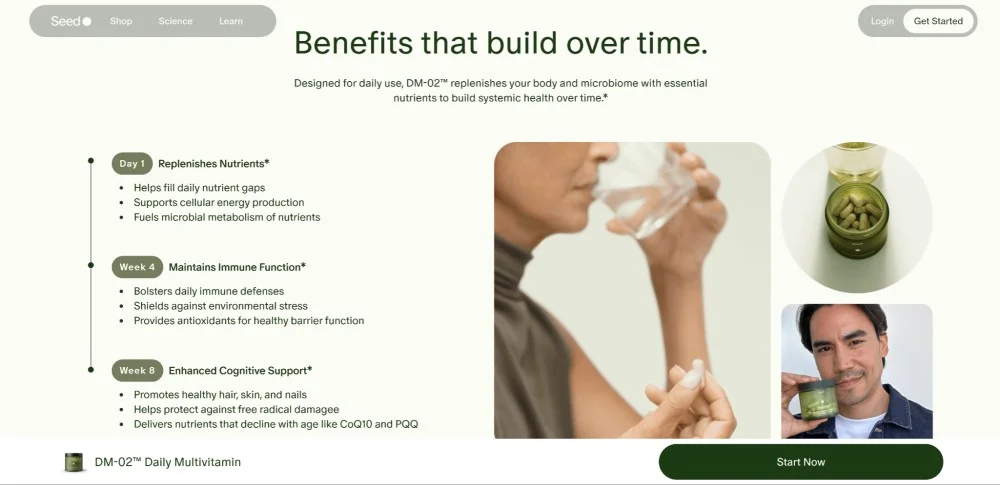
Naturally leading to a subscription (note the subtle add-on nudge for cross-sells on discount in the cart):
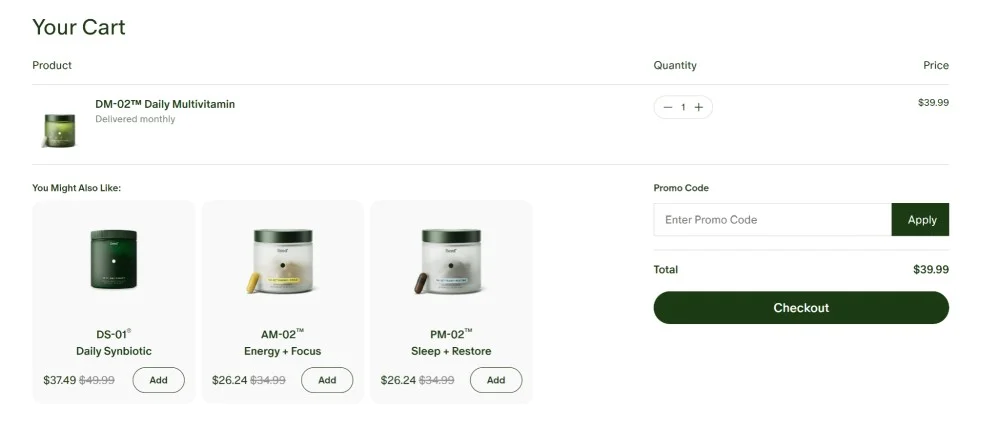
What you can also do, for your health supplement’s store marketing:
- Make subscriptions easy to start, easy to skip, and easy to modify (like change dosage or pack sizes)
- Always show the savings over one-time buys (preferably use the cost-savings angle)
- Offer pre-built subscription boxes, as subtle cross-sells (or as upgrades on existing subscriptions), paired to health goals; like, “Immune Reset”, “Sleep Support”, “Gut Health Pack”
- Always show how long it takes for results to kick in, say something like “Most users see changes in 4–6 weeks”
Pro Tip: You can also offer bigger packs or multipacks as an alternative to subscriptions. The proposition is simple: “this is the minimum we recommend” – for example, a 10-count trial pack, 60-count monthly, or a 90-day efficacy box.
Lifecycle here means two things:
a) what in the shopper’s lifecycle led em’ to end up on your email list
b) where they are in their journey when they signed up – new, existing, or high-intent
So, the idea is to essentially ensure you have data collection set up at email sign-up points, like:
- Post purchase – map what product, what does it support, and maybe a quick quiz on the thank-you page or welcome email
- Exit-intent/welcome pop-up – dig in a quick quiz on what they’re looking for, and their age, for an extra incentive
- Product discovery quiz – your true best-case scenario (you needn’t work twice as hard)
This personal data will help determine how long a shopper’s lifecycle as a shopper will be. Here’s what you can do, as an example:
- Before purchase – teach them why your formula works, who it helps, what results look like
- After purchase – guide them on how to use the supplements right, some hacks, maybe
- A few days later – check in. Ask how it’s going
- Once they’ve seen results – celebrate, ask for feedback, suggest the next step (“here’s what else we can help you with”)
- When they’re nearing refill – remind them it’s time to restock or offer a subscription (if already not on one)
- For loyal customers – share new studies, ingredient facts, (like, why y is a better solution to x), invite to follow on socials for more relatable content, and offer more ways for you to earn (referrals – hit health goals together)
Here’s a great example from Vimergy, note how they circle back on back to school season (targeting existing customers as new subscribers), showing why their immune support supplement for kids is great:

Also read: 20 eCommerce Lifecycle Email Marketing Examples for Maximum Engagement
People don’t buy supplements they know nothing about.
The goal of putting out content is to make them trust what’s inside the bottle (and also help retain shoppers).
What you need is content that educates, not sells. Think:
- Ingredient deep dives (the process, sourcing, research paper overviews and maybe feature products that have these ingredients)
- “What’s Inside Your Supplements”, “How to get the most of out {supplement} for supporting {condition/goal}”, “Build a {goal} routine” blogs
- Real conversations with medical professionals, fitness experts, and community
Nuun Hydration does this really well. They feature a learn section in their navigation, housing education pathways. Ranging from ‘about us’ to content pathways on ‘why hydration matters’ how to build a habit; and ‘community updates’ (apart from the blog, ofc):

And you don’t gotta stop at just creating content on your store’s website.
If you’re up for it, start a weekly live Q&A. For example, “Ask a Nutritionist” sessions where people can just ask questions and learn.
Or record a short podcast that unpacks supplement myths. Then turn clips into bite-sized Reels or TikToks.
You can also engage in online communities, like forums for disease support on Reddit, or Facebook groups. The point isn’t just to create content, it’s to make sure people see it, and actually get feedback.
Pro Tip: Add a simple blog section under each episode or live session, with key takeaways, ingredient mentions, and links to products. You’ll rank for long-tail keywords without even trying.
Sure, you can run a loyalty program for repeat sales, but what if it were as simple as:
Feature a ‘Quick Reorder’ button on the header, like Vitacost does:

Remember, shoppers in the healthcare, wellness, and nutrition segment need to feel a level of continued service.
Meaning, you give them consultations, savings, and ease of use.
To market your health supplements store better and retain shoppers, ensure that shoppers can:
- Reorder really quickly – to see recommendations on order history
- Consult and update prescriptions – with the help of experts, of course (telehealth, duh)
- Check their saved payment options – like HSA/FSA/insurance (if eligible)
Pro Tip: Keep a close eye on shoppers in your email list who go through help articles after a purchase (which means it may be time to reach out in real time or via email).
Also read: How To Improve Healthcare eCommerce Stores’ Conversion Rate – 29 Amazing Ideas
Retargeting is easily the cheapest, yet the most effective form of marketing for online health supplement stores.
Why? Shoppers who have bounced often need the right nudge, like a bit of education or a consultation.
Just ensure you start right on your store’s website, while shoppers are still on there.
If someone’s been lingering too long, something’s not sitting right with them.
What you can do after 30-45 seconds of inactivity is trigger a:
- Product walkthrough popup
- “Still browsing?” nudge
- Bundle suggestion based on cart
- “Need help with your {last ordered products}?” nudge
Here’s how One Sol does it:

The best part is: you can use this same on-site retargeting strategy for your email subscribers as well as shoppers from your ads.
Pro Tip: Use first-party cookies to remember shopper data, this way, you can segment the follow-up between existing shoppers and new shoppers, for example:
- “Still figuring out your routine?” → send a quick email or SMS check-in to existing shoppers
- “Need to talk to a specialist?” → nudge with live chat or support booking for new shoppers from your ads
Also read: Best Advice from Forums (Reddit, Quora) for eCommerce Word of Mouth Marketing
Research shows emails convert 2x more than any other channel when it comes to the health and wellness industry.
However, your supplement store’s cart abandonment campaigns have to educate on the value before pushing discounts.
So, make sure your drip campaigns escalate the value – “We saved your cart” (loop in a discount if you have one) > “What’s stopping you?” (loop in a quiz) > “Here’s what you’re missing.”
Take some inspiration from how Hiya, the supplements brand, directly calls out “Don’t put off your kid’s health” and simply shows a quick reminder in their first cart recovery email:

Pro Tip: Personalize your cart abandonment flow for your online health supplement store by creating segments based on:
- fitness level (beginner, intermediate, advanced)
- health concerns (weight management, sleep issues, stress)
- product usage frequency (new users, occasional, loyal)
- purchase motivations (prevention, disease support, enhancement)
All you need to do is target shoppers with a quiz in the second cart recovery email.
Also Read: Healthcare Email Marketing: 26 High-Converting Examples (+ Templates)
Window shopping for eCommerce supplements stores is one laced with anxiety and doubt.
And it’s not like supplements are returnable – refunds are doable, but not exactly great for margins.
This is why, instead of a 30-day refund window, flip it. Let people try first, then pay if they stay.
Exponent Beauty does this smartly. They charge $0 at checkout, but the card only gets billed after 14 days. That’s enough time for someone to see progress, get hooked, and stay on.
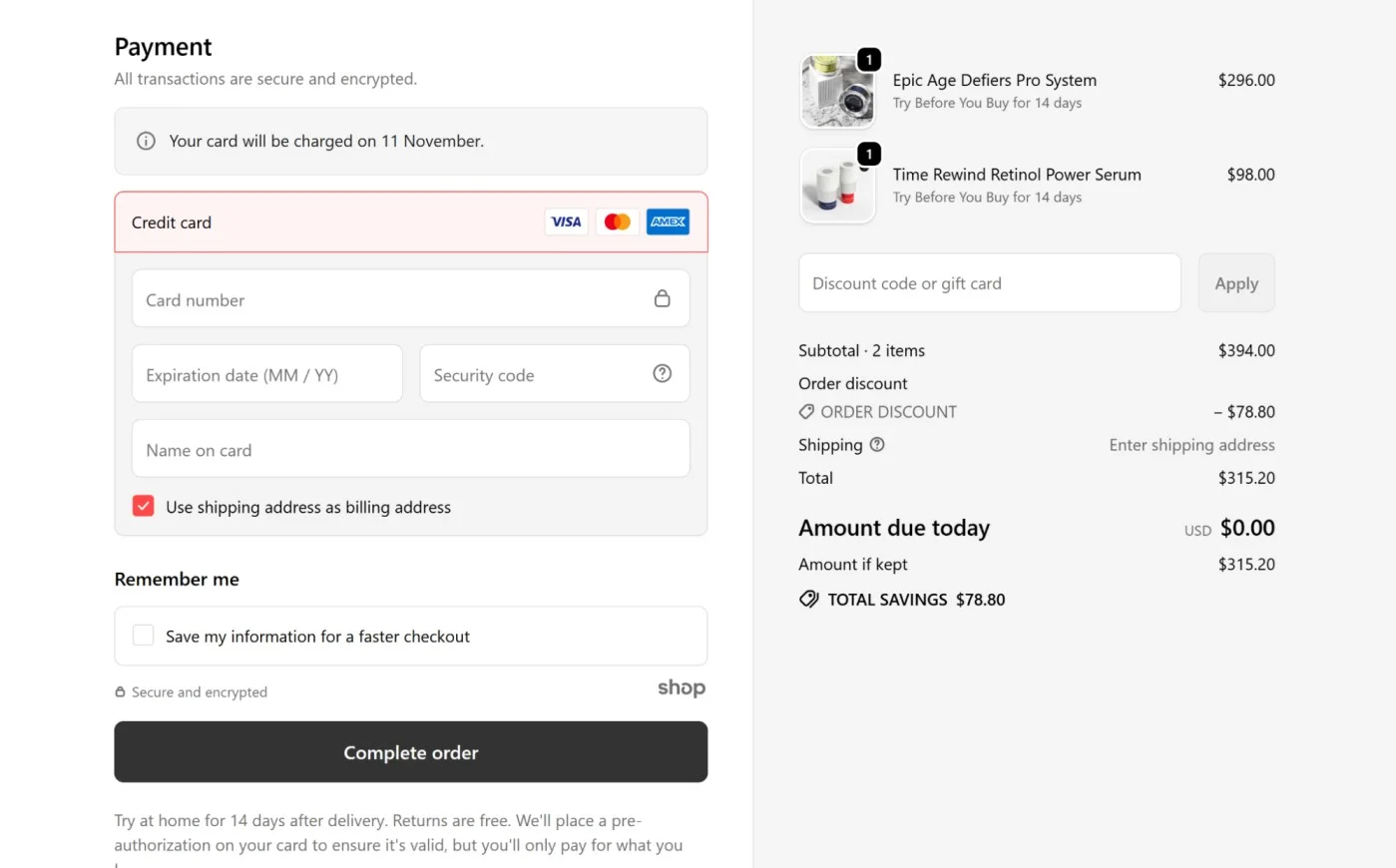
Pro Tip: Set reminders a few days before the trial ends. Ask how it’s going. If they reply or engage, hit them with a retention nudge — “Extend your results with a 3-month plan.” And, if you’re a relatively new store, this marketing strategy works better than a subscription plan upfront. 😉
Also read: Preventing Buyer's Remorse: How eComm Stores Can Curb Post-Purchase Anxiety
Almost every fitness freak owns a smartwatch. Most joggers log runs on Strava.
So, why not configure your store’s CMS or email marketing tool to log challenges and how shoppers take supplements on fitness tracker apps?
This way, you not only have personalized medical data to configure your marketing with:
- Activity recaps
- Set future goals
Diagnose if something goes wrong with supplements (not working as expected, side effects, or other red flags)
A great example: Nature’s Sunshine runs challenges to keep shoppers engaged, and this way, your customer churn becomes a butter churn:

To go beyond recovering churn and truly power up your health supplement store’s retention marketing, try these:
- Celebrate shopper milestones (like brand and shopper anniversaries, 3rd reorder, etc.)
- Create a leaderboard where scores tally across challenges – like submitting photos (the reward has to be exclusive brand benefits)
- Hold actual real-life events, like limited edition workshops on purchase of certain products, where shoppers can come together to interact with your brand
Also read: 20 Powerful Ways To Reduce (And Prevent) eCommerce Churn
Most supplement stores have longer than usual product pages and as a result, the product discovery process, becomes, erm, undiscoverable. 🙂
So, the best way to tackle this? Bring up cross-sells, contextually, for example, you can:
Add a simple comparison chart – “When to take {standalone} vs. {bundle}” – do this if you’ve multiple products that support a particular goal/symptom (like a standalone supplement vs. a bundle)
Feature related products by intended usages – for example, if a shopper’s on a “morning energy” supplement page, feature an expandable tab/section under a callout with copy and imagery showing “looking for night calm too?”
Pressed Juicery nails this — they show subtle add-ons and bundles right in the cart. It doesn’t feel like an upsell. It feels like a better idea.
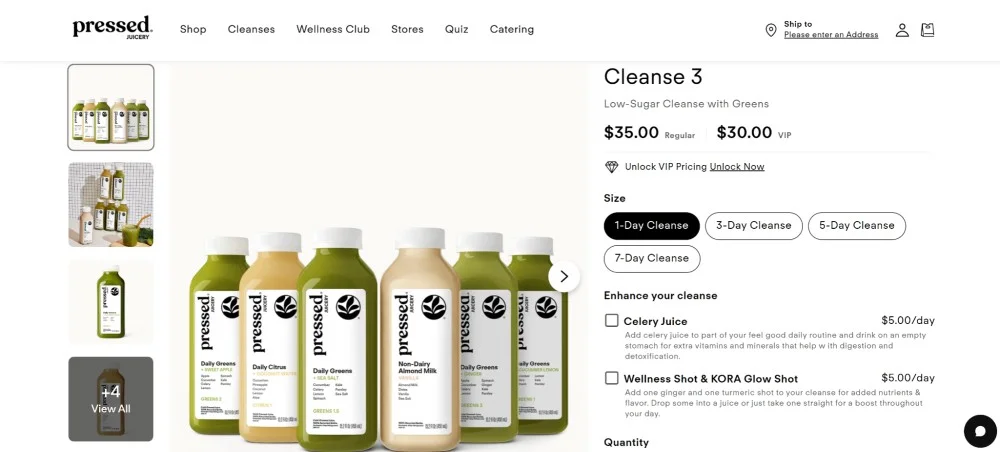
Show what not to combine, too. That kind of honesty sticks — and it sells more in the long run.
Also read: How to Cross-sell on Product Pages—Without Being Pushy (+ Examples)
Nothing builds recall like letting people try your stuff.
So if you’re sponsoring or showing up at an event, make it a full experience.
Don’t just hand out sachets.
Mix your supplement into the event — smoothies, drinks, pre-workout samples, post-run recovery shots — whatever fits.
Keep the packaging interesting. Add a “scan to open” or “scan to unlock reward” QR. You get a trial and data in one go. Now, isn’t that nice? 💡
Then, retarget those who signed-up with a thank-you email or SMS. Maybe throw in a one-time offer or a “join the challenge” invite.
Pure Sport did exactly that for the pre-launch of their new flavor in a race – they distributed their Hydration salt as a sprinkle-on add on for watermelons (which are usually handed out in races):
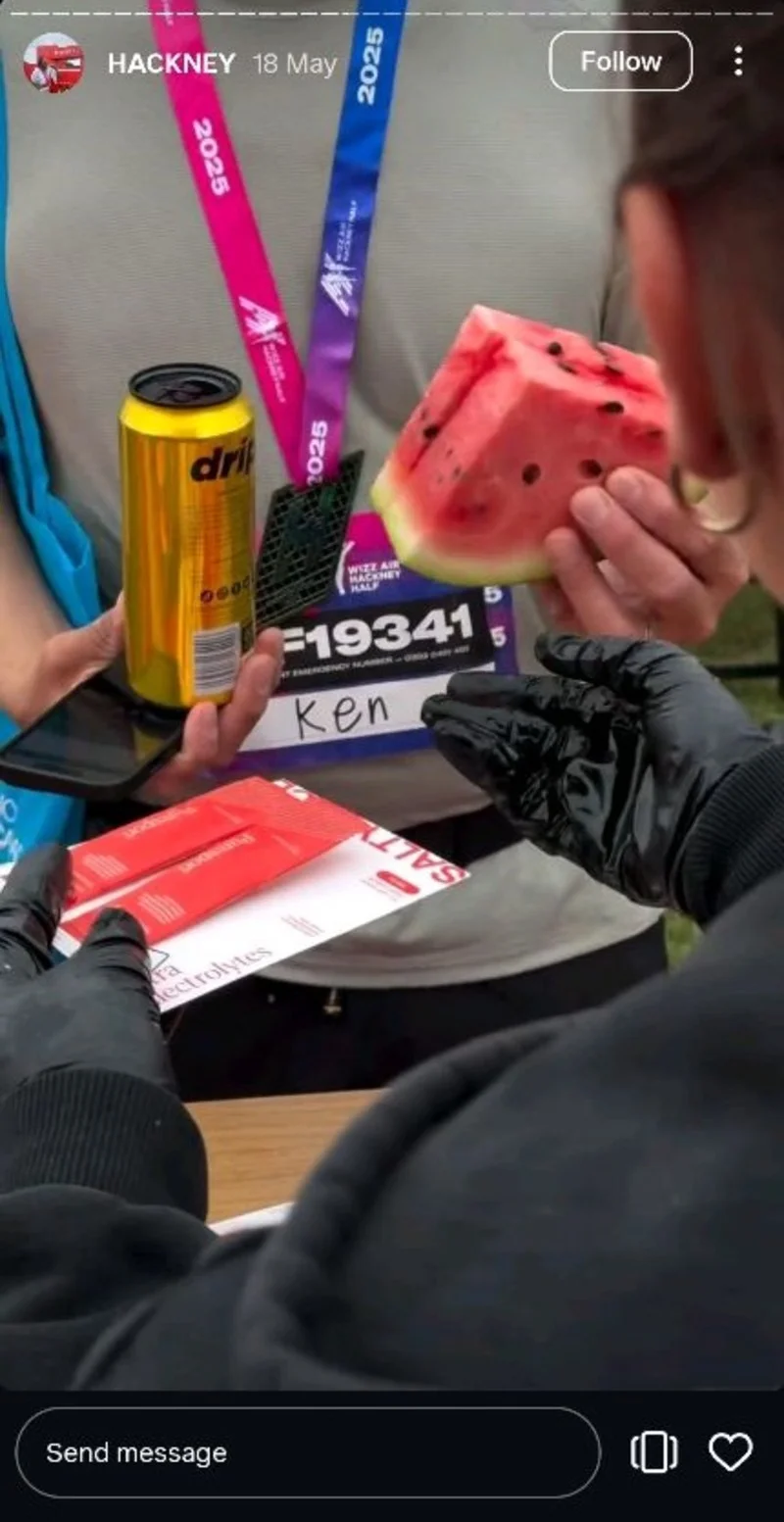
The result of this? Over 10,000 people were waitlisted to buy for the official launch of the new flavor, on the online store. Now, make of that, what you will.
Also read: Lessons From 6 Kickass Pre-Order Campaigns (eCommerce)
Stars and reviews are fine – but community builds obsession.
Instead, highlight customer stories and real-time discussions. This is how Feals shows the power of their community by looping in photos of their shoppers holding Feals packages:

While reviews always work, if you want your supplement store’s community marketing to convert like crazy, try these ideas:
- Feature UGC carousels – Real patient selfies using your product across your homepage, category, product, and even your cart pages
- Show dynamic community counters – “Join 12,345 patients on our gut‑health program”
- Feature your social feed – or you can embed Instagram posts tagged #MyGutJourney
Or you can always throw in your expert panelists, like Buoy does, by pairing clinical proof with community proof:
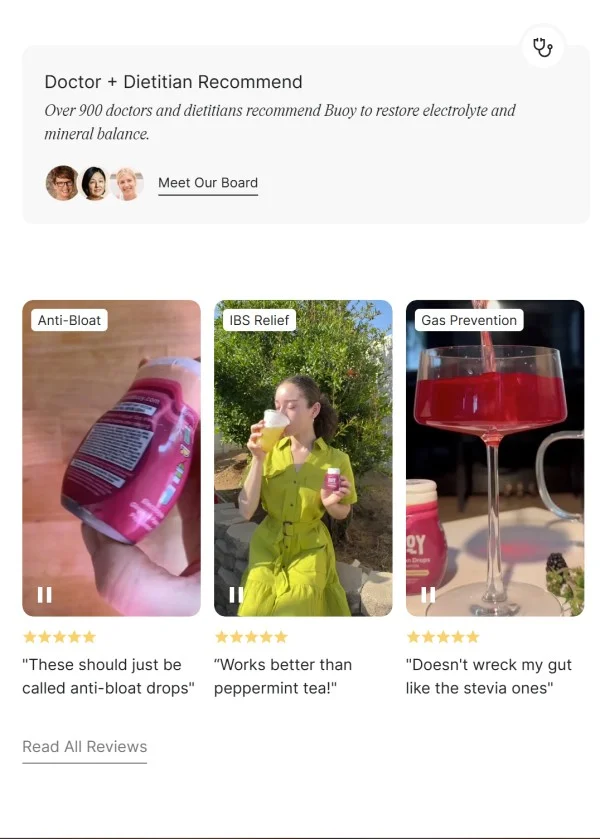
Pro Tip: Want to keep your mentions growing? Run a Facebook/Reddit/Discord community (with active rewards and regular events).
Healthcare isn’t always self-explanatory. Let your experts speak. Not everyone will try a quiz.
Here’s how Dr Sturm features a whole landing page for virtual consultations:

You can also:
- Maintain a calendar of livestreams on topics, like “Ask a Nutritionist,” “5 Myths About Gut Health,” “How to Start a Supplement Routine”
- Partner with other brands in wellness to create events
Pro Tip: Invest in affiliate programs, where you get practitioners to get the benefits of being in partnership with your brand.
Also read: 31 Creative (Yet Economical) Ways To Drive Traffic To Your eCommerce Store
Not every influencer needs a million followers to market your supplement brand.
Micro-partnerships with pilates instructors, nutritionists, or even therapists can bring niche but loyal traffic.
What you should look for:
- the influencer aligns with your core brand values
- doesn’t collaborate with every brand on the horizon
- focuses on a particular niche (like post-natal healing, or anti-aging)
Here’s a perfect example of this in action – a thought leadership YouTube podcast video series from Arielle Lorre, a fitness influencer:
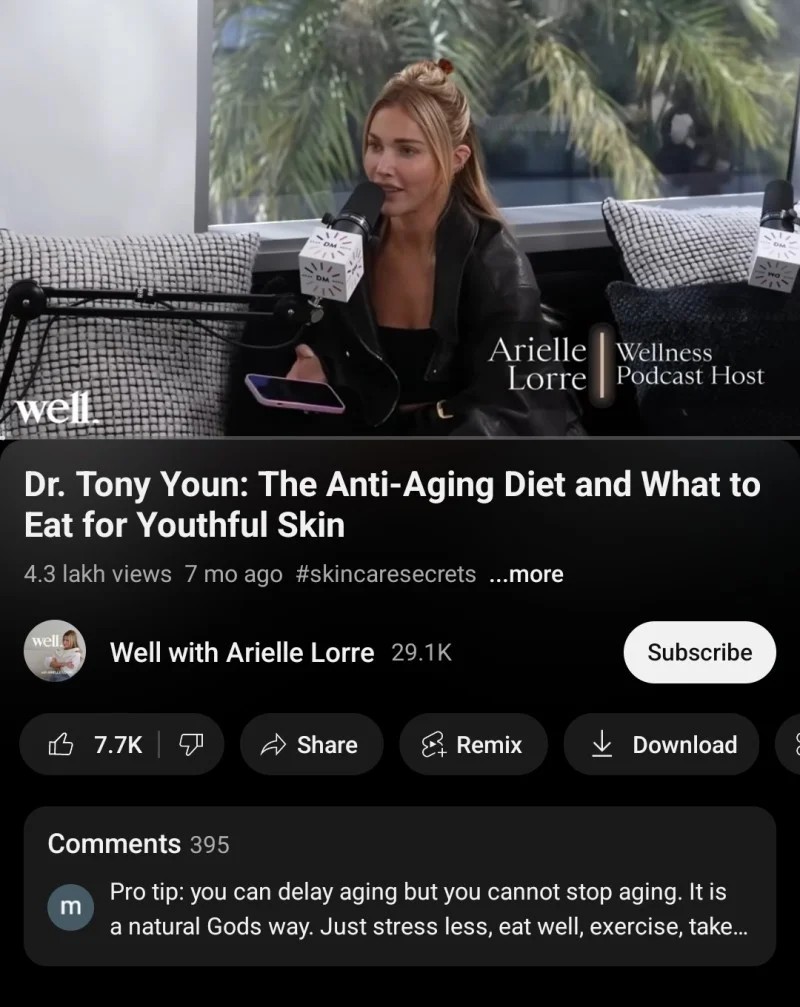
The best part is: you can build a whole content system out of collabs.
- You can repurpose snippets from videos into ads
- Use as email intros
- Highlight quotes from them in your PDPs or even plug the videos
Pro Tip: Give each partner a unique bundle with a custom landing page (“Sarah’s Wellness Stack”); it converts better than coupon codes and builds long-term recall. Plus, you can track the exact revenue lift. 🙂
For supplements stores, the biggest hidden challenge: misinformation.
So instead of pushing new claims, start by busting bad ones.
Find the myths that stop people from buying.
Ask your support team what shoppers claim in their live chats and what sort of misconceptions exist about dosage, timing, and side effects.
That itself becomes your content strategy. Here’s what you can do:
- “Myth or Fact?” carousels on your Instagram posts and stories
- Short YouTube clips where your expert says, “Let’s clear this up…”
- A monthly “Myth Mail” email newsletter that debunks one misconception at a time
- PDP description sections, like “Heard this before? Here’s the truth” or tackle questions in microcopy like, “Can I take this every day?”
Estroven uses this marketing strategy on their product page, they feature a “real facts, no myths” section on their product page:

Pro Tip: You can even reuse this “Mythbusters” content in your supplement store’s ad campaigns. That way, when someone searches or clicks an ad around a particular topic, you can lead them to a custom landing page, with an exact timeline, “how-tos”, and expert-led content.
Also read: 40 High-Converting Health/Beauty "Product Page" Examples
Personalization shouldn’t be a black box.
Whether you offer custom formulas or routines, show how it’s tailored.
Add logic or reasoning post-quiz – or, show how you have done it for other shoppers like FloLiving does:

Some more personalization ideas for your online health supplement store’s marketing:
- Show dynamic banners based on referral source (email, social, paid ads)
- Feature “Recommended for you” modules powered by past behavior or quiz data
- Include time‑sensitive alerts (low stock, order-time cutoff for next‑day shipping)
- Apply discounts only on a few products – ones that fit the shopper’s conditions
Pro Tip: Use major holidays as “wellness checkpoints” to keep shoppers reeled in – craft themed bundles and messaging that both support your customers (mental reset, self‑care) and nudge them toward your core goal (e.g., weight loss).
Example: For “New Year, New You” (Jan 1), launch a “Resolution Reset Kit” email featuring your:
- metabolism‑boosting supplements
- 5‑day meal‑plan PDF
- a “Stay on Track” 10% off coupon
Also read: eCommerce personalization: 20 revenue generating examples
Build in public. It works. Because people relate to your story, and even more, it shows evolution.
Here are some things you can share on your product pages, email flows, and even PDP banners:
- New clinical trials
- Packaging upgrades
- Sourcing changes
Here’s how Canary Clean does it: by showing their live television feature, influencer collab, and a blog post on their best-selling product:

Pro Tip: Segment out your existing buyers on your email list before you go public with an update. Send them a quick “thanks for getting us here” note and give perks like early access, whether it’s a new flavor, better packaging, or an upgraded blend. This really helps with retention and loyalty!
Discovery is the #1 challenge on supplements stores.
No one wants to answer 50 questions to get one supplement that will help them poop better.
Nor will they go through 30 products to decide, not with a doom-scroller’s attention span. The simple way out? Give them pathways right at the get go, like Hers does in the first fold of their homepage.
Apart from a rotating notification bar showing benefits, they show various pathways with promises of results (note the ‘ease perimenopause’, ‘get glowing skin’, etc.:
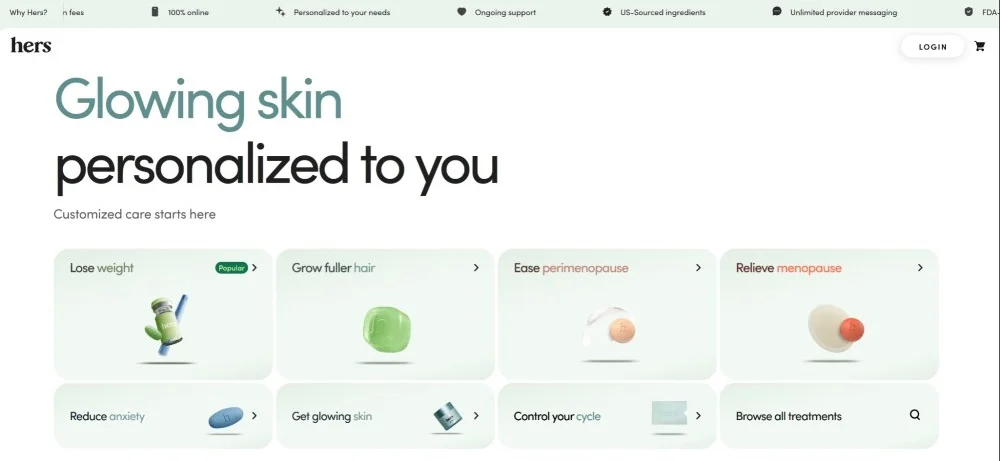
What’s also a must:
- Load up your search bar with pre-filled queries
- Show ‘shop by goal’ in your navigation menu
- Feature a video quiz, like Love Sweat Fitness does
They create a quick walkthrough quiz with short videos (almost reminiscent of video game walkthroughs):

Also read: eCommerce Navigation Best Practices For 2025
People are tracking everything these days. Weight. Hair growth. Heart rate.
Nearly half of all Americans have used a wearable device at least once, so if you aren’t helping shoppers use that data, you are leaving money on the table.
Help people visualize how your product fits into their lives. Fertility timelines, supplement cost savings, period tracker integrations – whatever fits your brand.
Here’s an example from Natalist and their cycle calculator:

Pro Tip: You can retarget with the result and product links to match – say something like “You’ll need 3 cycles to optimize – grab the 3-month bundle here.”
No one remembers the ad that looks like every other ad. Especially in the supplement industry, where scroll fatigue is real.
Use storytelling, weird hooks, or unexpected testimonials (real ones, ideally).
Think: “I thought adaptogens were fake until THIS happened,” or “My sleep got worse before it got better. Here’s why.”
You can also try: Humor or mini-skits. They get shares. Here’s Hims, a sexual wellness supplement brand’s ads:
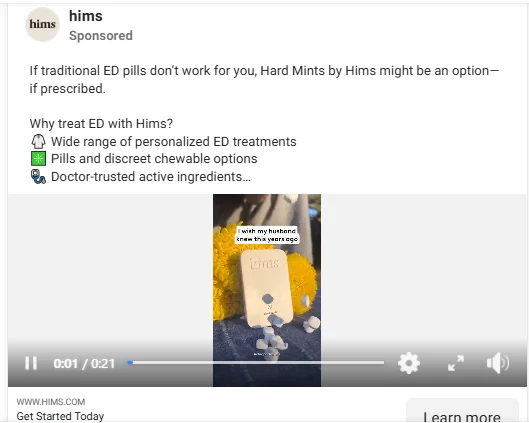
Pro Tip: Build a funnel that qualifies people before the CTA hits. For example, only show the “Book Now” ad after someone has watched your explainer past the 50% mark. That way, you’re not pitching cold.
Service is marketing. Period.
You can’t afford to lose sales or customers over delays.
Offer a live chat with actual humans, but let an AI handle it first. Research shows most people below 60 are comfortable discussing concerns with an AI bot – here’s how Tru Diagnostics takes advantage of this:

The goal here is to:
- Use AI chatbots to answer common questions instantly (dosage, side effects, shipping)
- Offer live chat with real agents for prescription or health-related concerns
- Add a “Talk to a Pharmacist” feature (if you have that available)
Pro Tip: Highlight response time in chatboxes (“Typically responds in under 1 min”) to reduce hesitation.
Just because you sell to individuals doesn’t mean you can’t target businesses.
You can offer a whole separate website/landing page for professionals, or a per-sale basis commission – here’s how Periosciences does it:

Pro Tip: Don’t sleep on bulk orders. Make it effortless for B2B buyers to buy directly—think gyms, clinics, spas, and wellness programs.
To increase bulk orders, your healthcare store’s B2B landing page should include:
- Clear copy + visuals that highlight bulk order benefits
- Upfront mention of minimum order quantity (MOQ) and FAQs
- A prominent “Talk to Sales” option in the first fold
- Curated bundles tailored to business types (e.g., Clinic Starter Pack, Employee Wellness Bundle)
Where your shopper is can change what they need.
For example, if they’re coming from an email, keep the conversation going; send a nudge saying:
“Hey, that immunity bundle you checked out is now 10% off.”
The idea here is to build context and make your store feel all the more personalized.
You can also use geo-targeting to highlight:
- local delivery
- highlight reviews and experts matching the shopper’s region
- redirect to local versions of your store (works even for international visitors as well)
Here’s how Spotlight Oral Care redirects to its partners in the US:

Big brands fight for big keywords. You don’t have to.
Go after the “weirdly specific” stuff – like “best iron supplement for postpartum fatigue” or “does magnesium help with restless legs?”
Note how the term ‘ear drops for ear wax, vegan’ gets ad visibility for smaller brands:

Pro Tip: These terms might get less traffic, but the intent is 🔥. Add-to-cart buttons on blog posts? Even better.
If you aren't bringing in quality traffic, your CVR will always be low down. The only way out? Get in some quality traffic.
AI isn’t here to replace your marketing team. It’s here to make them faster.
You can use it to summarize reviews into clean takeaways:
“Most users noticed results in 3–4 weeks.” Here’s a great example from Five CBD:
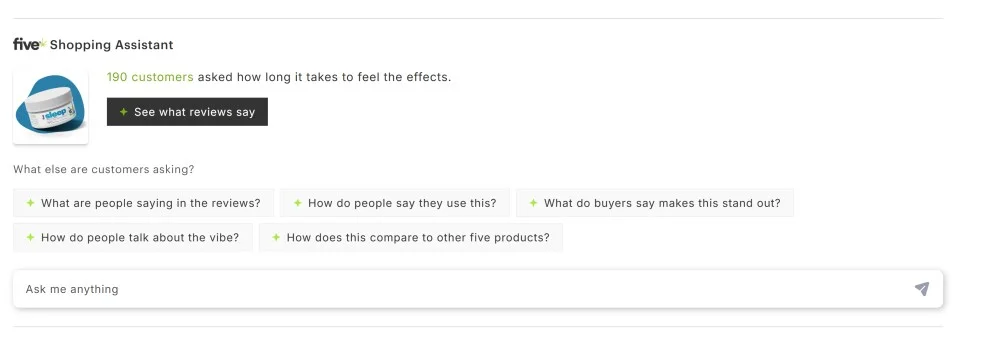
You can also use AI to:
- Surface questions that come up often, right within your first fold
- Draft replies to reviews — in your brand’s voice – this way, customers don’t feel ignored
- Suggest content topics based on search trends – like, “best magnesium for sleep” or “should I take probiotics daily”
Pro Tip: Before you publish anything AI helps with, scan for the language on claims. Replace words like treats or cures with supports or helps maintain. You stay compliant, and still sound human.
Also read: Using AI for Conversion Rate Optimization: 7 Proven Strategies for eCommerce Stores
You don’t need to sound like a scientist. You need to sound like someone who actually takes the product.
Instead of saying “Clinically proven adaptogenic compound,” say “Helps your body handle stress.”
That’s what people understand – and remember.
Add a short section on every product page: what the ingredient is, what it helps with, who it’s for, and how long it takes to notice results (take this example from Pendulum):
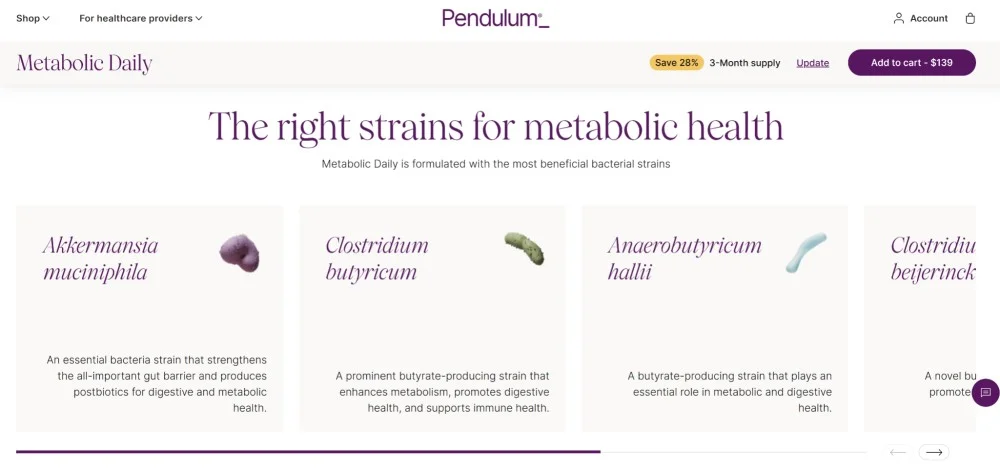
Visuals help too. A small “How it works” graphic or a “Magnesium glycinate vs citrate” table does more than a paragraph ever could. Here’s a great example from OPositiv Health:
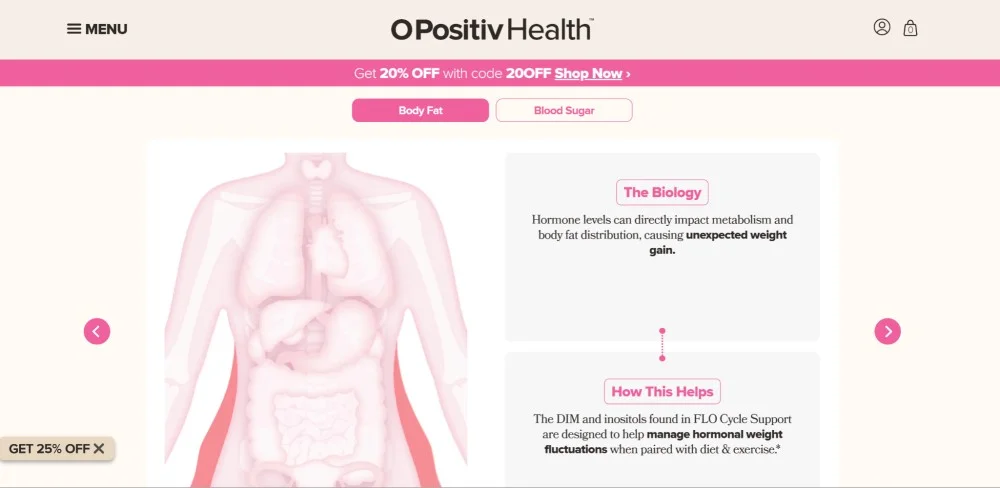
Pro Tip: Use real-world comparisons. “Think of magnesium as your body’s chill button.”
Everyone’s got expert quotes on their product pages. Cool.
But that’s where most stop.
Because content shouldn’t just sit there and explain. It should make people move (like, literally)
If someone’s on your site, give them something to do, like:
- Show products that fit with what they’re already checking out
- Add a small workout or daily tip in your blogs – “5 moves to reset your posture between Zoom calls”
- Drop short interactive bits in emails – “Desk-bound? Here’s your 1-minute recharge”
Sun Warrior gets this right. They don’t just list benefits, they let shoppers browse recipe ideas with their supplements (and housing it beneath the expert recommendation section is just genius):

So, when they show how to use their stuff (like recipes, expert tips, and small habits), they naturally trigger the endowment bias (signalling that their product can be part of a shopper’s routine).
This is what autopilot looks like.
Start by building trust, not hype, or pull in insane amounts of traffic.
Three quick ideas:
Right now — functional wellness.
Think sleep, stress, gut, focus, and longevity.
Basically, anything that helps people “feel better” without needing a doctor’s note. But, the flip side is: some ingredients may need FDA approval.
Anything that fits daily routines (morning greens, stress relief, focus blends) is growing like crazy.
If your brand plays in that space, lead with science and habit-building — not miracles.
Not really, but you need to keep a close eye on what you say.
Why? Because the FDA views supplements ‘close to food’ – but not food.
But you still have to label ‘em as dietary supplements. Meant to provide certain shortfalls in diets, supplements can be anything from enzymes, gummies, powders, tinctures, gummies, etc. Goal's to either help users arrive at a certain goal or manage some conditions - like better sleep, better hair.
However, here are three types of supplements that exist per FDA regulations:
1. Nutrient-Based Supplements (vitamins, minerals, amino acids)
These are your classic essentials — think multivitamins, omega-3 capsules, protein powders, iron, magnesium, B-complex, collagen, etc.
They supplement the diet by adding nutrients people might lack in food.
Common forms: capsules, tablets, gummies, powders.
Strictness: Pretty straightforward; as long as the ingredient is recognized and your label avoids disease claims, you’re in the clear.
⚠: You can say “supports energy metabolism,” but never “treats fatigue.”
2. Plant/Bioactive-Based Supplements (herbs, botanicals, extracts, probiotics)
These target specific functions like sleep, gut health, or stress.
Think ashwagandha, turmeric, valerian root, ginseng, green tea extract, probiotics, etc.
They’re considered dietary supplements if they’re taken by mouth and not marketed as drugs.
Common forms: tinctures, powders, capsules, functional beverages.
Strictness: FDA watches this group closely for unverified medical claims.
⚠: “Helps support relaxation” is fine. “Treats anxiety” is not.
3. Functional or Specialty Compounds (enzymes, metabolites, new dietary ingredients)
These are the new-age, science-backed supplements – metabolism boosters, gut enzymes, NAD+ precursors, adaptogenic blends, etc.
They often fall under “dietary substances present in the food supply” or “new dietary ingredients.”
Common forms: powders, capsules, blends, performance sachets.
Strictness: You must check if your ingredient existed in the U.S. before October 15 1994. If not, it’s an 'NDI' and needs FDA notification.
⚠: Claims need data, not hype. Stick to “supports recovery” over “accelerates healing.”
Make people come back.
That’s it.
You can pour money into ads all day, but if shoppers buy once and disappear, it’s over.
So build systems that make shoppers return — smarter subscriptions, habit-driven content, and service that actually provides a level of care.
That’s how you grow and sleep at night.
The rules remain the same: how you show your supplements online, right from packaging and presentation to claims and copy, has to follow FDA and FTC regulations. 🙂
Basically, ensure that you:
✅ Clearly show what your ingredients are
List all, and mention what they help with (not what they treat)
✅ Include proper dosage instructions
Or warnings, if there are any (like consult a doctor, not ideal for pregnant women, or kids below the age of 5)
✅ Display a disclaimer (even if you use FDA approved ingredients)
Like, “These statements have not been evaluated by the FDA. This product is not intended to diagnose, treat, cure, or prevent any disease”
✅ Label every product clearly as a “dietary supplement”
Then comes the actual marketing part – figuring out the story behind your brand:
- Who are your customers
Health-conscious people, busy professionals, athletes, or vegans.
- Where do your supplements fit best
Do they support everyday wellness or help fill nutritional gaps? The answer changes your entire message (and even approvals).
- What makes your brand different
Cleaner sourcing, higher transparency, faster results, better science, community-backed? And more importantly, can people instantly connect your product to their goal?